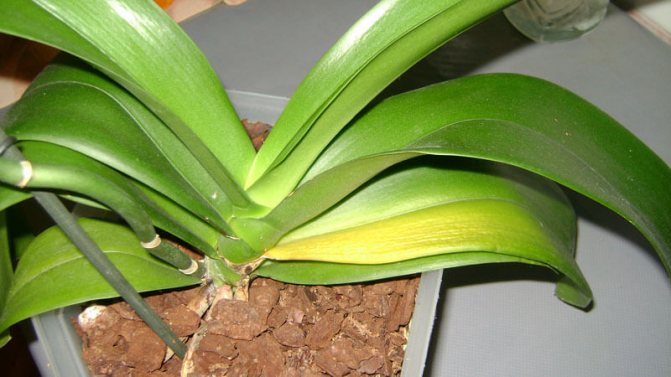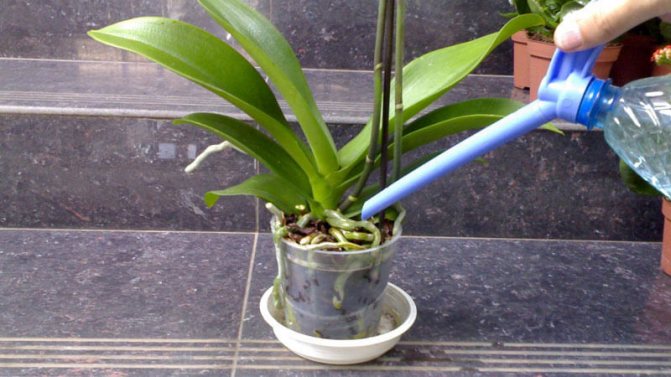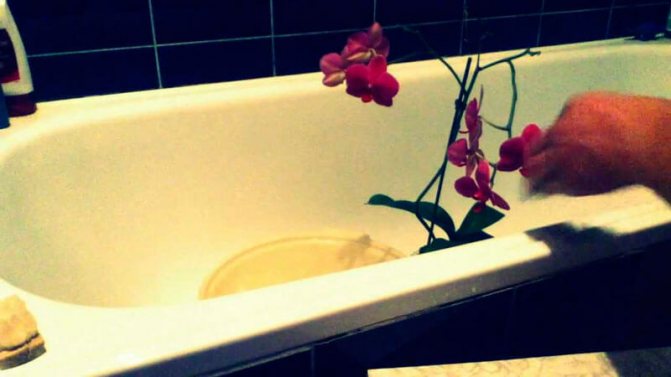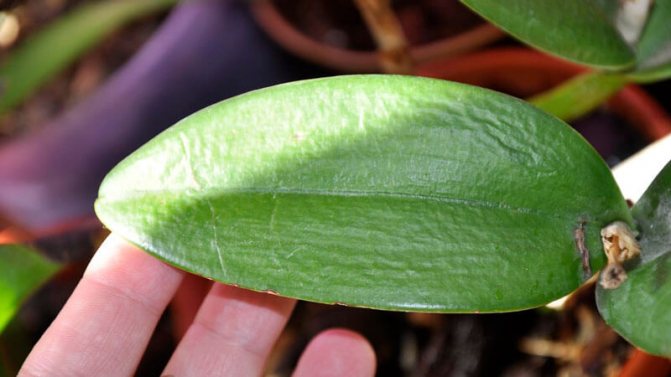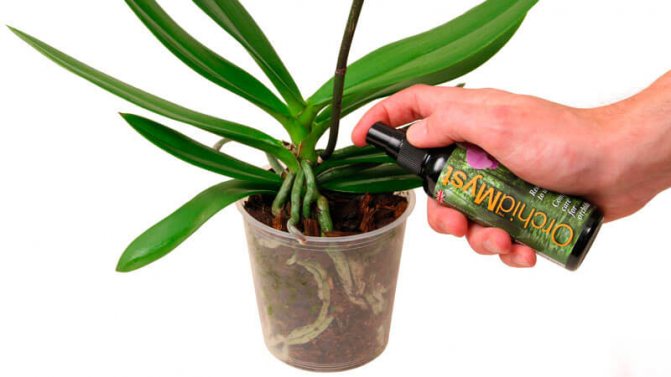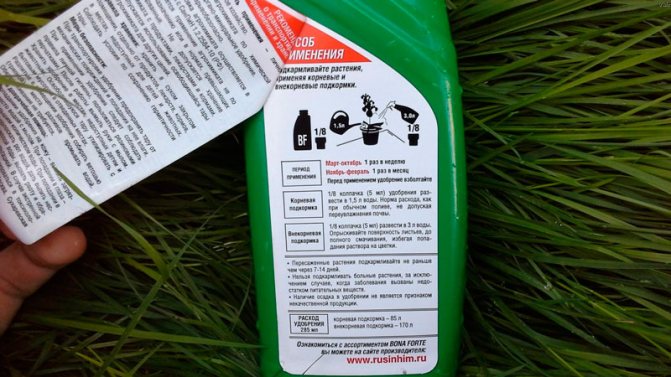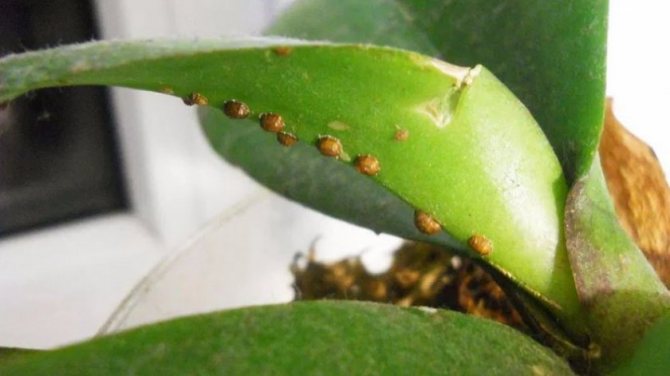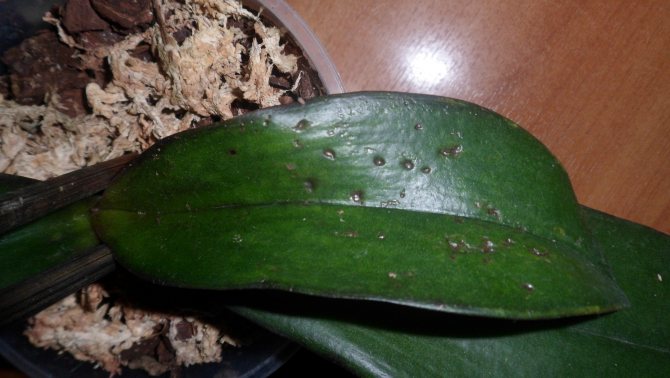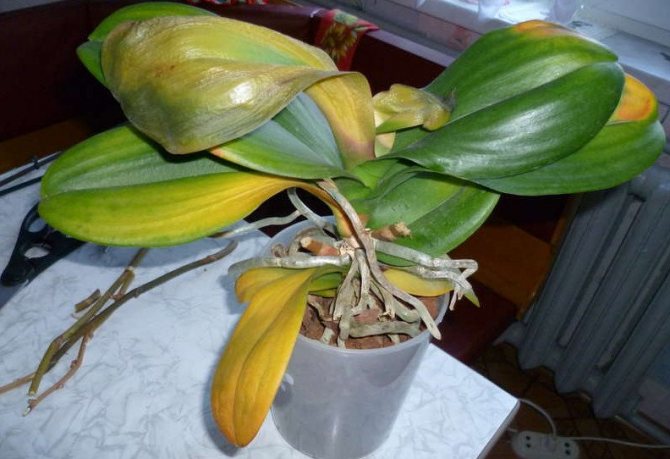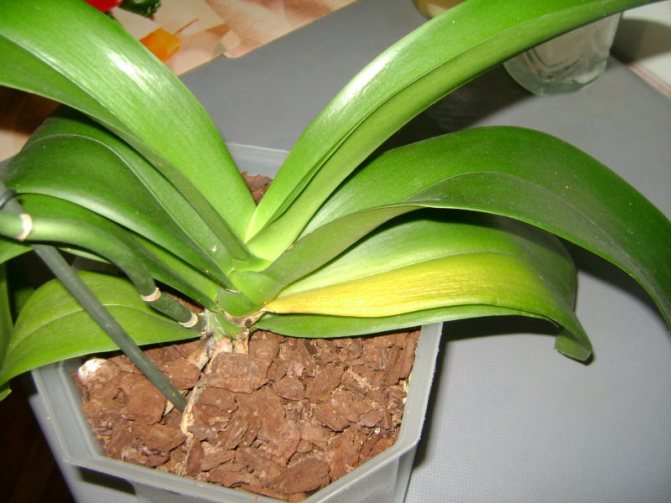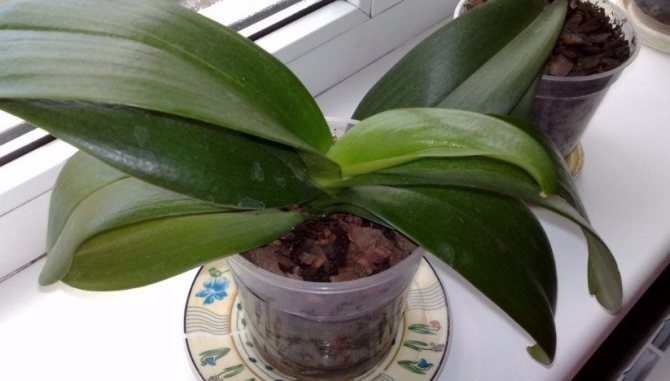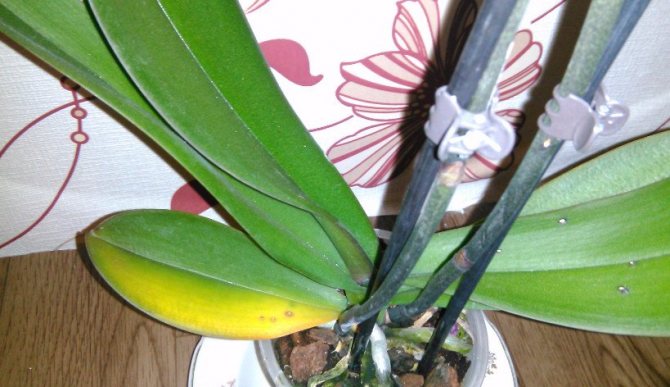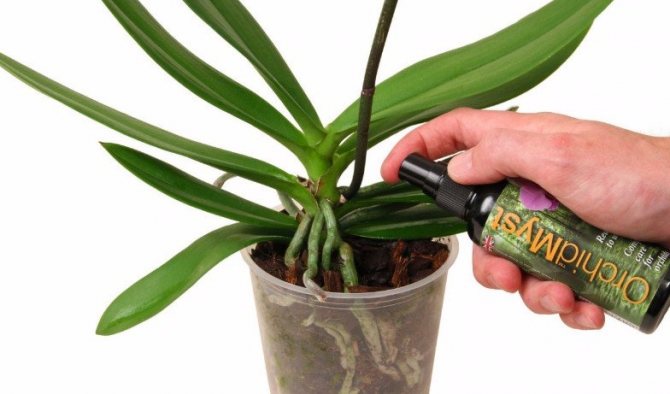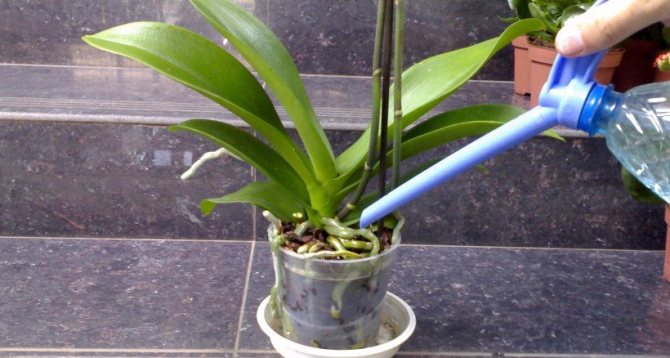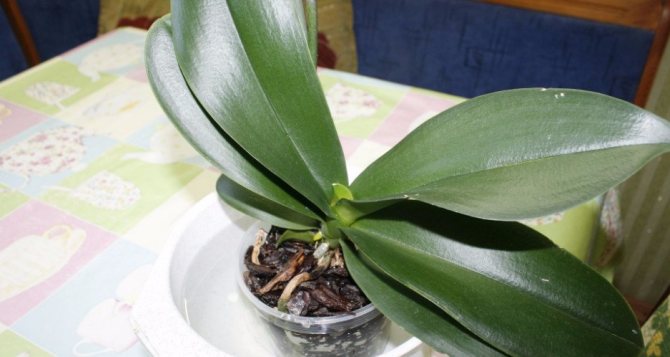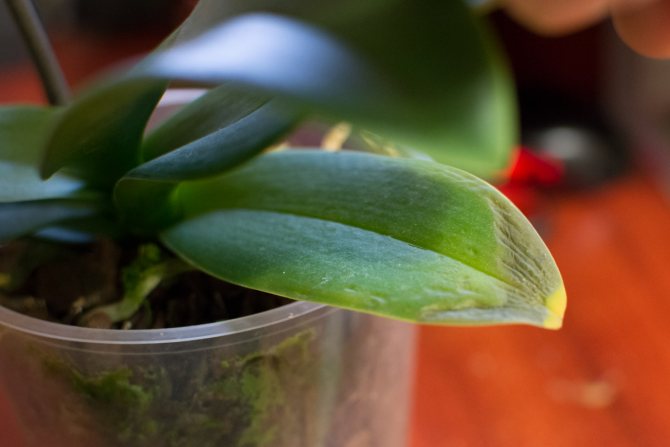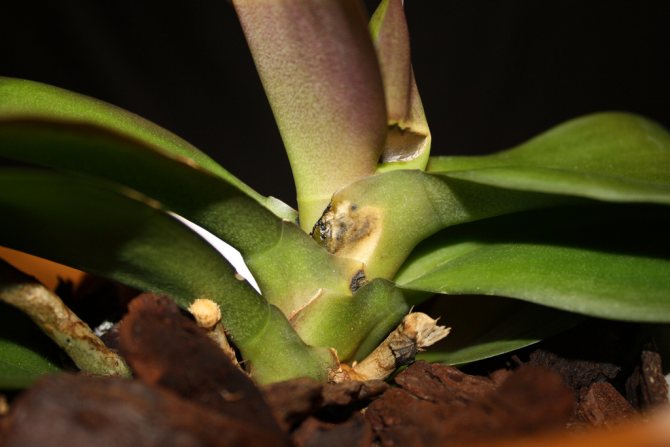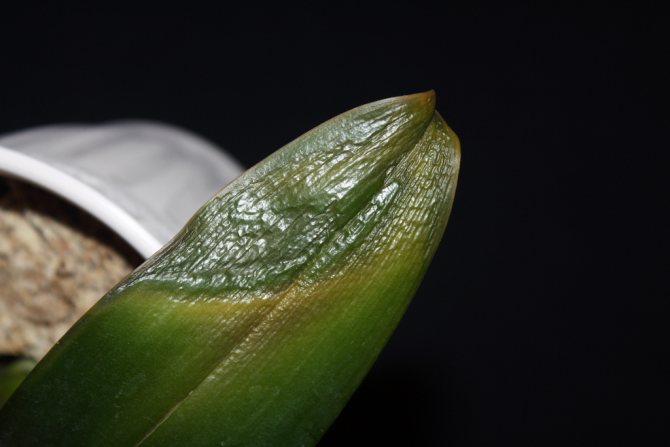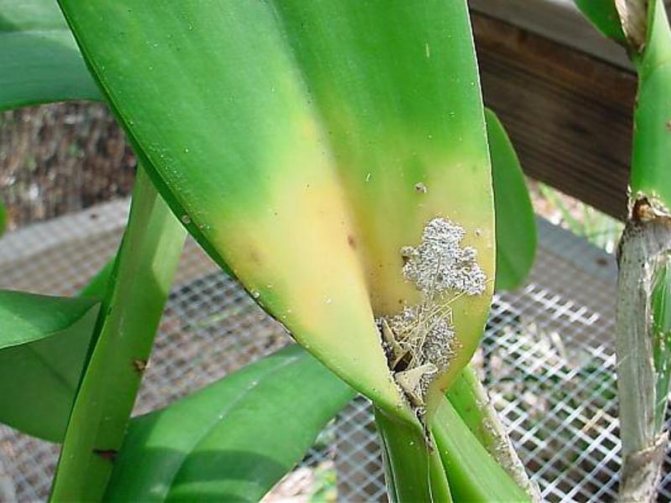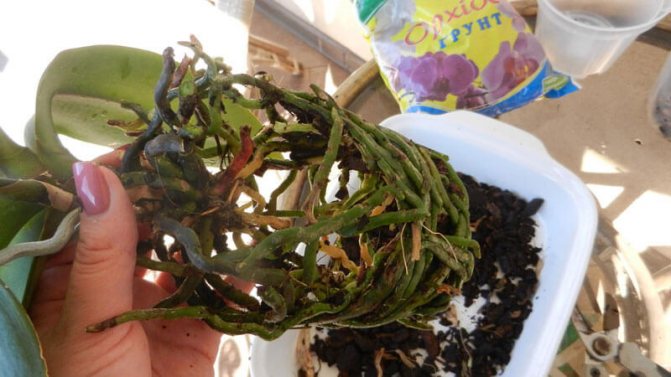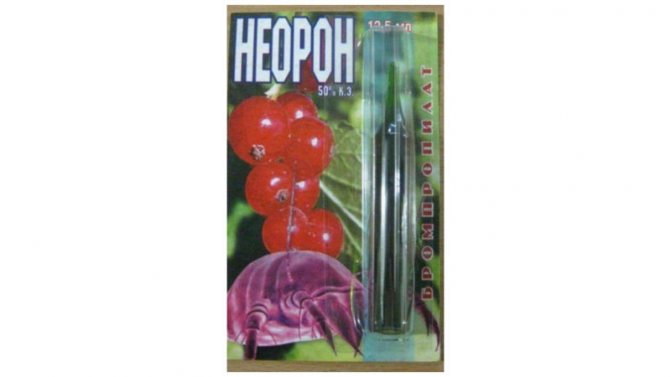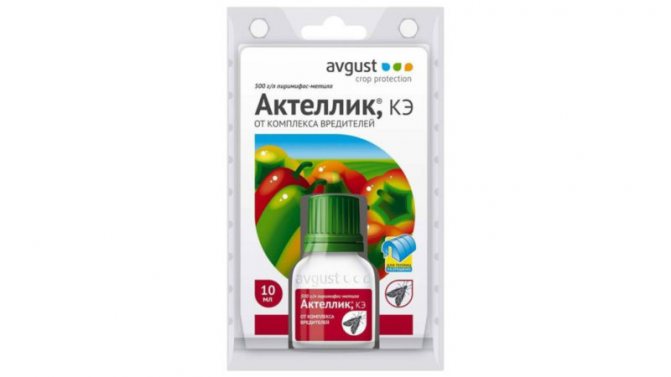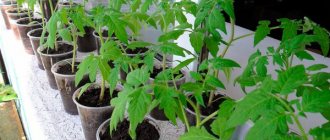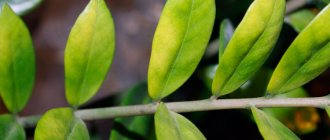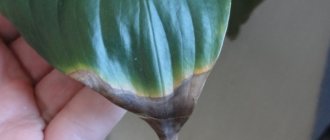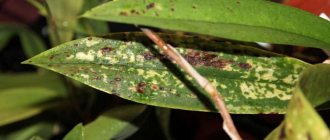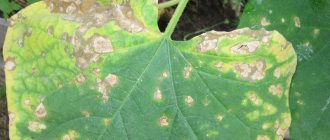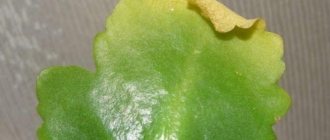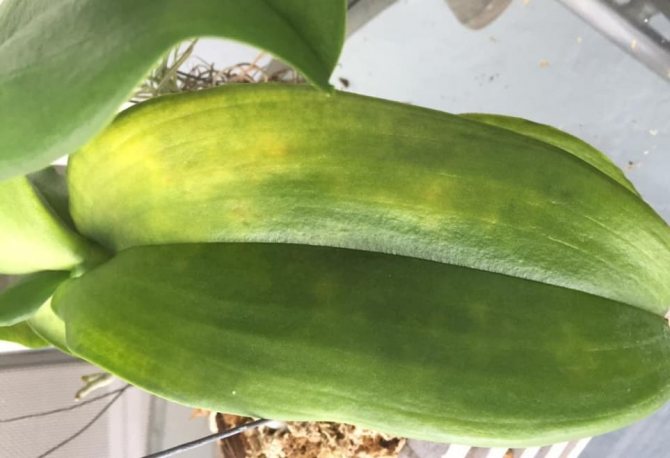
The aristocrat of the home greenhouse, the orchid can bloom almost all year, no one else has such a riot of colors and variety of forms. Most orchids, seemingly fragile and delicate, are actually very hardy and resistant to growing conditions. With some care, even such vigorous flowers begin to hurt. If the leaves of an orchid turn yellow, it means that something in the conditions of its maintenance does not suit it. You need to understand what prevents this exotic flower from living and take urgent measures to eliminate the causes of yellowness.
The most noticeable sign of orchid trouble is yellowing of the leaves. There are several reasons for this process:
- aging of leaves;
- insufficient watering;
- excess moisture in the substrate;
- too much sun;
- lack of lighting;
- nutritional errors;
- pests and diseases.
We will consider each reason in more detail.
Aging leaves is not a reason to panic
One or even two yellowed leaves on an orchid do not give cause for great concern. This can manifest the natural aging process of the leaves. Each plant leaf has its own lifespan. Leaves are replaced gradually. In common orchids such as Cattleya or Pafiopedilum, the lower leaves turn yellow and fall off. Less often, two leaves may turn yellow and fall off. In orchids from the genus Dendrobium, the bulbs may be completely leafless. In this case, you do not need to take any measures, this is a natural process, the old leaf turns yellow, dries completely and disappears on its own. You should not help the plant in this process, cutting or tearing off the leaves.
Important! Forcibly cutting off the yellowed parts can injure the orchid, leaving an open wound.
In this case, the yellowing of the leaves proceeds very quickly. The leaf turns yellow in 1–4 days. Much depends on the age of the flower. The leaves themselves remain on the plant for several years, after which they fall off. This is as normal as fall leaves in autumn.
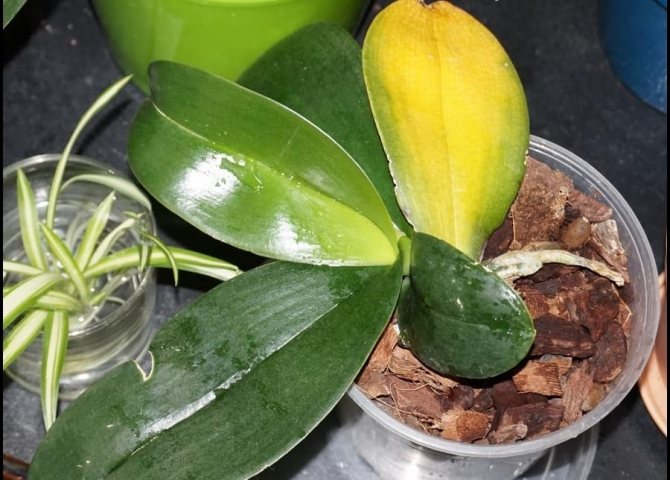

Dry air
For the sake of maintaining optimal temperature conditions, many place orchids near heaters and central heating batteries. This is a mistake, because as a result of such a neighborhood, the air dries up, leaving the orchid without leaves.
The fact is that water evaporates not only from the soil, but also from the greenery itself. The plant loses moisture and the leaves begin to gradually die off. The answer to this problem is the periodic spraying of the orchid from a spray bottle with water at room temperature.
Wet moss laid near the flowerpot also helps. He is able to concentrate moisture in himself and share it with other plants. The main thing here is not to overdo it, otherwise the fungus may appear.
Insufficient watering as one of the main mistakes in care
A very common reason for the change in the color of orchid leaves from green to yellow is insufficient watering. Why do orchid leaves turn yellow due to overdrying of the substrate? Moisture deficiency disrupts metabolism, slows down the supply of food to the stems and leaves. The reaction of the flower in this case will be the appearance of an unhealthy color of the leaves. This happens only in the most neglected case.
For example, phalaenopsis. Unpretentious, common orchid. In a healthy outwardly plant, with normal roots, the leaves acquire a yellowish tint.This situation is possible even with timely watering. The reason for the lack of moisture in orchids is the structure of the planting soil. Orchid planting mix most often consists of pieces of coniferous bark.
Irrigation water, flowing through the substrate, flows into the sump, preventing the roots from absorbing moisture. Young leaves lack nutrients and Phalaenopsis has to redistribute nutrients from older leaves to young ones. Old orchid leaves turn yellow. In this case, it is very easy to eliminate such yellowing.
It is enough to water the orchid using the immersion method. The phalaenopsis pot is immersed in a container of water. The immersion time is individual. Through the transparent walls of the pot, you can see when the roots of the orchid turn from gray to greenish. This will be a signal that the roots are saturated with moisture. If you switch to such an irrigation system, in one or two weeks the water balance of the flower is restored, and the yellowing of the leaves stops.
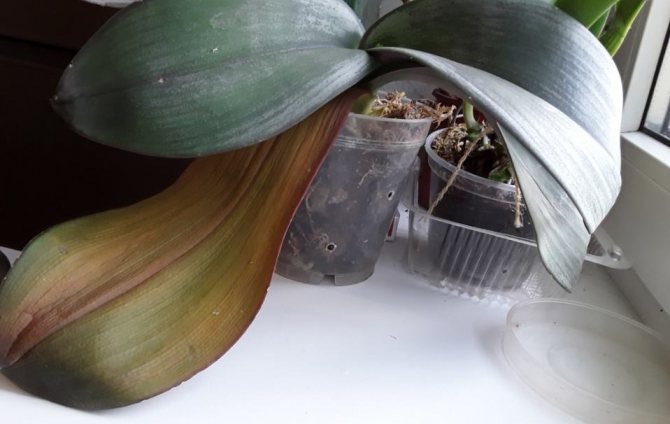

Further care of the orchid
Orchid peduncle: causes of diseases and methods of dealing with them
If the plant has been reanimated, further care must be properly organized, otherwise the weakened flower will get sick again. To do this, it is necessary to prevent waterlogging of the soil and regularly feed Phalaenopsis. Good illumination is of great importance. For the prevention of new diseases, it is necessary to carry out a visual inspection of the orchid leaves as often as possible. Such an examination will help in time to identify any symptoms of trouble: yellowing, wilting, or the appearance of cracks. Do not forget about a timely transplant. If the foliage at the base of the stem begins to fall off, wrinkle or burst, urgent action must be taken, otherwise the orchid may dry out.
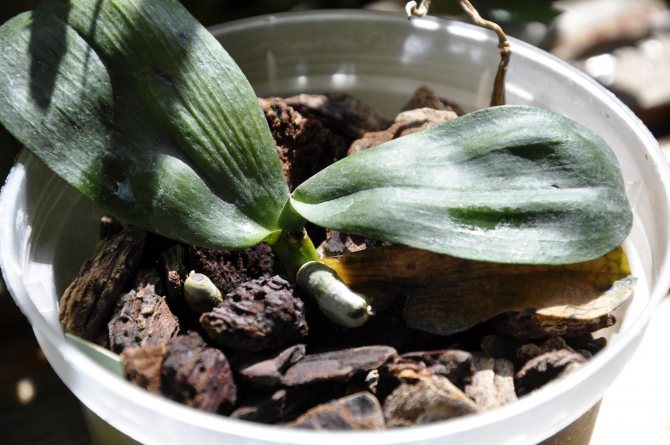

The main thing is not to repeat the mistakes that led to the disease of the plant.
Experts say that most of the problems in caring for Phalaenopsis are caused by the improper microclimate in the room. Therefore, if it is not possible to create suitable conditions for an orchid, it is better to choose a plant that is less capricious and demanding to care for. Phalaenopsis and other varieties of tropical "guest" need careful and delicate treatment.
Excessive moisture in the substrate - and as a result, yellowing of the foliage
Most often, leaf diseases occur for this reason. Flower budding lovers express their care in watering. The harm from such "care" is obvious - lack of oxygen at the roots, reproduction of putrefactive bacteria. More experienced orchid breeders warn against the dangers of determining the moisture content of the substrate from the top layer. The bark on the surface dries very quickly, and deeper the planting mixture is still quite wet.
If the orchid is growing in an opaque pot, use a wooden stick. It is placed in the substrate near the rim of the pot. After a few minutes, the stick must be removed. A dry torch will indicate that watering is necessary, and a wet torch will warn against excessive watering. After a while, it will be possible to determine the need for watering by the weight of the pot. The lighter the pot, the less moisture in the substrate.
You can understand that the leaves of an orchid turn yellow due to excessive watering by the following signs:
- the color changes in the whole plant, and not only in the lower leaves;
- black spots can be seen on the leaves;
- leaves become soft and moist;
- darkened and blackened roots;
- an orchid growing in a pot can be easily removed from the substrate.
What if the leaves of an orchid turn yellow because the substrate is too wet? The plant needs to be urgently transplanted into another substrate. Special attention should be paid to the roots of such a plant. They need to be trimmed to healthy tissue, and the cuts should be treated with charcoal powder or ground cinnamon.
Advice! Watering and spraying all orchids is necessary only with soft water.You can neutralize the hardness of tap water by adding up to 20% peat to the substrate.
An orchid planted after such an operation needs to reduce watering, often spray it with soft demineralized water. It will be useful to create a greenhouse around it that maintains constant air humidity.
The quality of irrigation water plays a very important role in the life of any orchid. For irrigation, it is necessary to use soft water with a minimum amount of dissolved salts, a slightly acidic reaction. Orchid roots consume a minimum amount of salt, the excess appears on the surface of the substrate in the form of a white bloom, the soil is covered with a bloom of salt. The soil must be replaced.
Saline substrates can be recovered by flushing with copious amounts of distilled water used for car batteries. An orchid planted in a fresh substrate is fertilized through the leaves - wiping them with a weak solution of fertilizers.
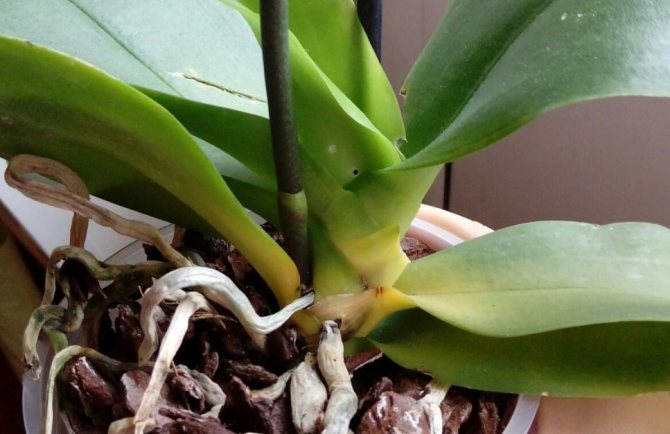

What to do if the leaves turn yellow
- If the cause is not aging, it may be due to a dramatically changed microclimate. After adjusting temperature, humidity and lighting, the problem will go away.
- If the plant is damaged, disinfection is necessary, growth stimulants are used for recovery. The orchid is provided with a gentle environment so that there is no undue stress.
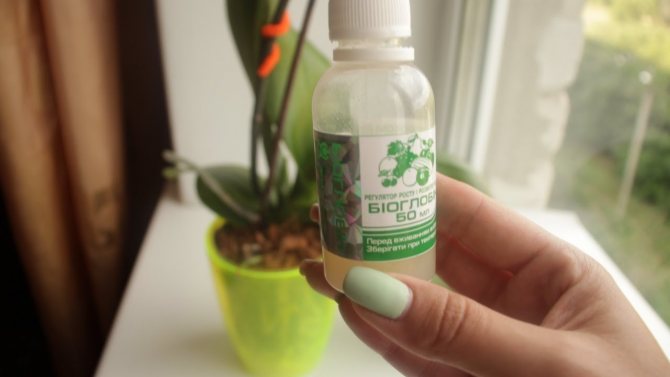

- Follow the watering schedule. With a lack of liquid, the plant is watered and in 7 days the condition improves. Excess water is eliminated by transplanting into a new substrate, subsequently controlling irrigation rates. In this case, the result will appear in 10 - 14 days.
- If necessary, then rearrange the flower to another window or in the middle of the room. The main thing is to avoid direct lighting or dusk.
- The flower will wither in a year if artificial increase is used with the help of dressings. The correct solution is to take it to a warm, bright place, feeding it no more than once every 2 weeks. First, a special fertilizer is added, reducing the concentration to 50%, with subsequent applications - nitrogen substances so that the foliage grows.
Read:
Why a wife cannot cut her husband's hair, and a mother's son: the essence of signs
Too Much Sun Is Not Always Good
The vast majority of orchids love good lighting. It should be bright, but diffuse. Orchids put up with direct sunlight only in winter. In the summer they need to be shaded, especially on the east or south windows.
Flowers growing on these windows will overheat and get sunburn. Burnt orchid leaves turn yellow and dry quickly. It is necessary to change the location of the flower, or you can protect it from direct sunlight by covering the glass with white paper. There is no need to cut off the fired sheet. A viable leaf will recover, and a dry leaf will fall off by itself. The plant will handle this on its own.
Lack of lighting - and the leaves turn pale, then turn yellow
In winter, when the daylight hours are short, there are few sunny days, and there is not enough lighting for the plants. The creation of additional lighting will help to lengthen the daylight hours. Phytolamps, fluorescent or LED lighting devices are used for illumination. Incandescent lamps will not work - they generate a lot of heat, thermal burns of the leaves are possible. It is better to turn on the lighting fixtures in the morning and evening for just a few hours.
Advice! The most light-loving orchids, Wanda, Cattleya or Lellea, are best kept in the east or south windows in winter.
The reason why the leaves of the phalaenopsis orchid turn yellow may be a lack of heat. When the temperature near the plant drops below 18 degrees during active growth or flowering, the flower can indicate this by yellowing the leaves. What to do if the orchid leaves turn yellow due to the lowered temperature - move the pot to a warmer place, and cover the small orchid with a transparent cap to keep warm.
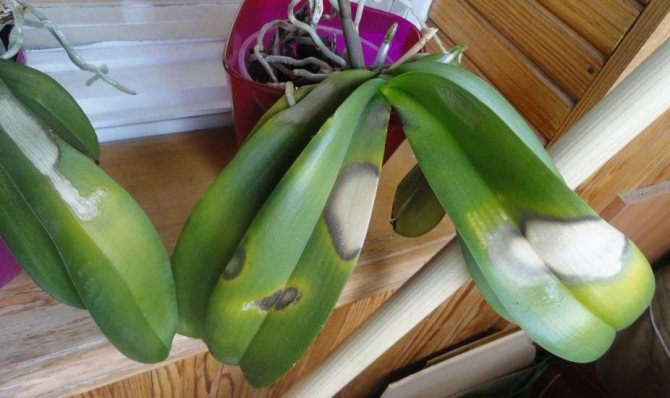

Sunburn on orchid leaves
Provoking factors
Phalaenopsis orchid, like other varieties of this tropical plant, is very moody. Not every florist can create proper conditions for her at home.
Often the flower loses its original decorative appearance - it turns yellow, withers and dries up.
There are some of the most common reasons:
- violation of the rules of watering, the duration of lighting, the level of humidity;
- drying out due to exposure to the sun;
- non-compliance with dosages and frequency of fertilization;
- the presence of diseases and pests;
- non-compliance with the transplant rules.
To understand why a flower goes missing, you need to familiarize yourself in detail with each cause and symptom.
Eating mistakes - overfeeding is not always in favor
Why do orchid leaves turn yellow and fall off due to nutritional errors? Orchids need to be fed with great care.
Do not fertilize:
- during the rest period;
- in the hot season;
- plants affected by pests and diseases;
- immediately after purchasing an orchid in a store;
- first month after transplant.
Fertilization is started a month after the plant is transplanted or after the end of the flowering of the orchid purchased in the retail network.
As a top dressing, specialized fertilizers for orchids are used, strictly observing the dosage on the package. The nutrient solution is watered, alternating with watering with pure water - one watering with water, one watering with fertilizer.
The appearance of yellow tips on the leaves indicates an excess of calcium in the substrate or irrigation water. In this case, you can save the orchid only by changing the substrate and watering the plant with soft, demineralized water with a slight acidity.
Rare dressings lead to a lack of potassium, leading to yellowing of the leaves. An uncompleted deficiency of this element contributes to the death of veins and the extraction of potassium from older leaves. Old leaves turn yellow and fall off. The only way to combat this situation is to enrich the substrate with potassium. In isolated cases, you can fertilize orchids with full fertilizer, diluted in half the dose.
Important! Fertilizers containing nitrogen, phosphorus and potassium in a ratio of 4-3-3 are intended for the growth of leaves and shoots, and with NPK 4-6-6 they stimulate flowering.
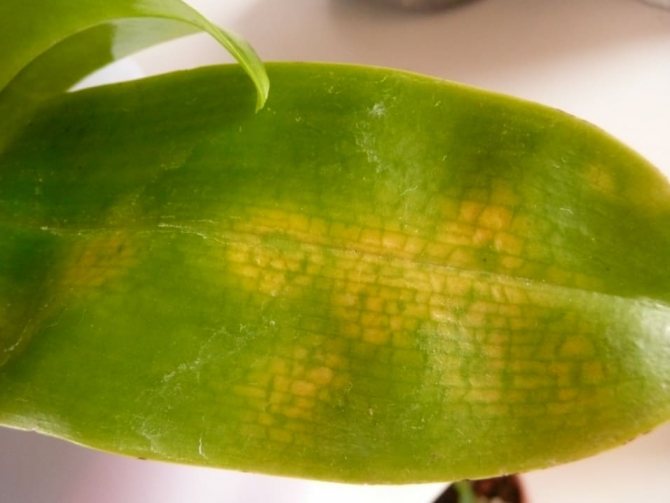

Transfer
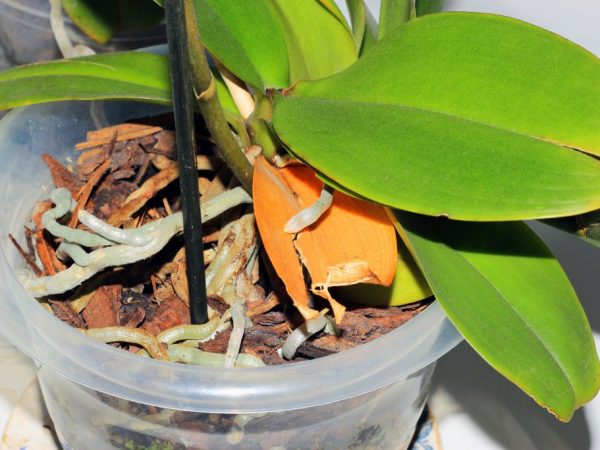

The pot must fit
Over time, the plant, which is rapidly building up green mass and air roots, becomes cramped in the old flowerpot. The roots are compressed, deformed, as a result the leaves, the central trunk and flower arrows turn yellow.
In order for such a flower to come to life again, it must be urgently transplanted into a pot 2-3 cm in diameter larger than the previous one. Do not take too large a container, because there is a high risk of waterlogging of the substrate and, as a result, rotting of the root system.
During transplantation, it is worth using sterile soil, which can be purchased at a flower shop. You can also prepare a soil mixture yourself by mixing chopped pine bark steamed with boiling water, sphagnum moss and charcoal in a 5: 2: 1 ratio.
Florists often make a mistake - they transplant an orchid with unblown buds or do not wait for it to fade. The plant gets severe stress and dies abruptly. Therefore, it is possible to move to another flowerpot only after the inflorescences have completely dried out.
Pests and diseases are another reason for yellowing of leaves
Another reason for the yellowing of the leaves is the poor health of the plant, caused by pests or diseases. The relationship between these two misfortunes is direct. The pests that appear on the plant infect it with infectious diseases, and the orchid weakened by insects cannot fully resist viruses and bacteria. The affected orchid withers, its leaves turn yellow and wither.
Most often found on orchids:
- spider mite - its presence betrays the appearance of a barely noticeable cobweb on leaves or shoots. Remove it with hot (40–45 C) water. The washed flower is kept under a shelter in an atmosphere of high humidity for up to three days. From chemicals used "Neoron" or "Tiofos";
- aphid - settles on the back of the leaf. They spread a fungal infection. Traces of aphids on the plant - a sticky bloom. You can fight aphids with any alkaline solution - an infusion of ash or laundry soap. In more advanced cases, Fitoverm or Biotlin can be used for residential premises.
Orchid diseases can also cause yellow leaves. A healthy plant receives a bacterial, viral or fungal infection from a patient through insect pests or care tools. All new plants must be quarantined for two weeks, separately from other residents of the home greenhouse.
The main signs of infection are round spots on the leaves, stem or peduncle. Later, dents or bumps appear in place of the spots. In the early stages of the development of the disease, fungicides will help to cope with it. In advanced cases, more radical measures are used - damaged parts of plants are removed to healthy tissue, the sections are disinfected.
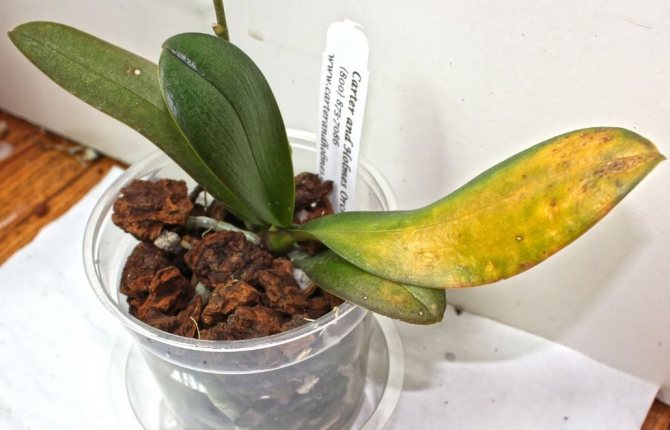

Instructions for saving leaves from falling off
To revive an orchid that has lost its leaves, you should pay attention to the roots. To do this, remove the flower from the pot and carefully examine the root system. If it is damaged or has a dry appearance, then first of all it is necessary to remove all the spoiled and dry roots. After this procedure, the cut sites are sprinkled with activated charcoal and the roots are immersed in warm water for 6 hours to saturate them with moisture. The plant is transplanted into a smaller pot with a new substrate, which is previously spilled with the fungicide Fundazol, and placed in a plastic bag or covered with a transparent container, creating a mini-greenhouse. Further, regular application of nitrogen fertilizers is required, which stimulates the development and growth of new leaves, and frequent airing of the greenhouse.

